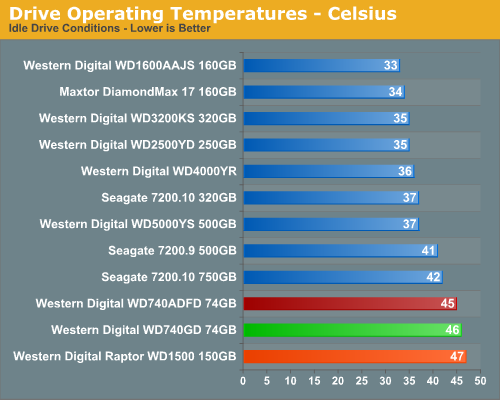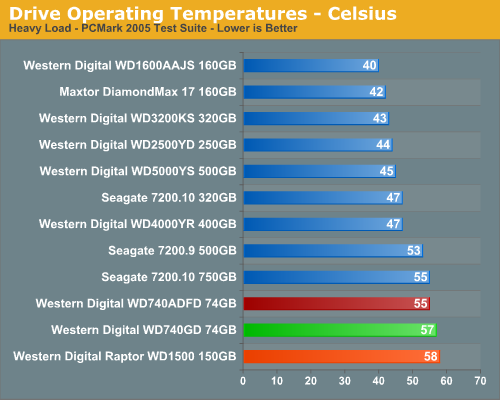Western Digital WD740ADFD: Bottled Lightning
by Gary Key on February 7, 2007 3:30 AM EST- Posted in
- Storage
Hard Drive Acoustics
Our acoustic test utilizes our standard test bed components but we implement AMD's Cool'n'Quiet technology and turn off the case fans to isolate as much case noise as possible during testing. Our OCZ power supply is nearly silent in these tests and our fanless ASUS 7600GS video card provides a further decrease in our case's ambient noise levels. Our drives are attached to the drive cage with rubber bushings to assist in isolating the noise of the drive without resulting harmonic changes due to the case design
Our acoustic tests are designed to measure the decibel levels while the system is at idle and also under load while running the General Hard Disk Drive Usage benchmark within PCMark 2005. We found through trail and error that this particular benchmark produces controlled readings across a wide range of applications within the benchmark. This particular benchmark utilizes 60% reads and 40% writes within the trace playback file.
The measurements are taken at a distance of 5 millimeters from the rear and front of the drive being tested in order to minimize surrounding environmental noise. We have noticed that unless we run a completely silent system in a silent room that measurements taken from 1 meter are generally not meaningful due to ambient noise levels. There are exceptions like the Raptor series of drives but overall most modern desktop drives are quieter now than the other components in the system.
The reported measurements are based on an A-weighted decibel score that measures frequencies similar to the way the human ear responds to sound. We take a total of three measurements for each test. We then subtract the high and low scores and arrive at our findings by reporting the remaining score.


Our Western Digital WD740ADFD is quieter than the other Raptors in our objective testing, but we thought the results would be even better after listening to the drive during testing. Our subjective opinion is that the seek requests on the WD740ADFD are muted a great deal when compared to the other two Raptors. In fact the difference was notable to us although it did not show up completely in our objective tests. Our base dB(A) level in the room at time of testing was 24 dB(A).
Hard Drive Thermals
Our thermal tests utilize sensor readings via the S.M.A.R.T. (Self-Monitoring, Analysis and Reporting Technology) capability of the drives and are reported by utilizing the Active SMART 2.42 utility. We test our drives in an enclosed case environment without the front fan operational to simulate temperatures that could conceivably be reached in a SFF or HTPC case design. We typically find the reported numbers drop anywhere from 18% to 25% on average when the front fan is operational.


We expected the WD740ADFD to run slightly cooler than either the WD1500ADFD or WD740GD drives due to the single platter design and it did. However, all three of the Raptors still run hotter than the other drives in our tests with the exception of the Seagate 7200.10 750GB drive that ties our test unit in the heavy load results. We highly recommend a fan be installed near the Raptor drives during normal operation.
Our acoustic test utilizes our standard test bed components but we implement AMD's Cool'n'Quiet technology and turn off the case fans to isolate as much case noise as possible during testing. Our OCZ power supply is nearly silent in these tests and our fanless ASUS 7600GS video card provides a further decrease in our case's ambient noise levels. Our drives are attached to the drive cage with rubber bushings to assist in isolating the noise of the drive without resulting harmonic changes due to the case design
Our acoustic tests are designed to measure the decibel levels while the system is at idle and also under load while running the General Hard Disk Drive Usage benchmark within PCMark 2005. We found through trail and error that this particular benchmark produces controlled readings across a wide range of applications within the benchmark. This particular benchmark utilizes 60% reads and 40% writes within the trace playback file.
The measurements are taken at a distance of 5 millimeters from the rear and front of the drive being tested in order to minimize surrounding environmental noise. We have noticed that unless we run a completely silent system in a silent room that measurements taken from 1 meter are generally not meaningful due to ambient noise levels. There are exceptions like the Raptor series of drives but overall most modern desktop drives are quieter now than the other components in the system.
The reported measurements are based on an A-weighted decibel score that measures frequencies similar to the way the human ear responds to sound. We take a total of three measurements for each test. We then subtract the high and low scores and arrive at our findings by reporting the remaining score.


Our Western Digital WD740ADFD is quieter than the other Raptors in our objective testing, but we thought the results would be even better after listening to the drive during testing. Our subjective opinion is that the seek requests on the WD740ADFD are muted a great deal when compared to the other two Raptors. In fact the difference was notable to us although it did not show up completely in our objective tests. Our base dB(A) level in the room at time of testing was 24 dB(A).
Hard Drive Thermals
Our thermal tests utilize sensor readings via the S.M.A.R.T. (Self-Monitoring, Analysis and Reporting Technology) capability of the drives and are reported by utilizing the Active SMART 2.42 utility. We test our drives in an enclosed case environment without the front fan operational to simulate temperatures that could conceivably be reached in a SFF or HTPC case design. We typically find the reported numbers drop anywhere from 18% to 25% on average when the front fan is operational.


We expected the WD740ADFD to run slightly cooler than either the WD1500ADFD or WD740GD drives due to the single platter design and it did. However, all three of the Raptors still run hotter than the other drives in our tests with the exception of the Seagate 7200.10 750GB drive that ties our test unit in the heavy load results. We highly recommend a fan be installed near the Raptor drives during normal operation.










26 Comments
View All Comments
AnnonymousCoward - Tuesday, February 13, 2007 - link
Good review. I don't think I'll ever buy one of these. For as expensive as they are, the storage size is small and the performance diff is minuscule. Sims2 loading: 30s vs 31s! MP4 conversion: 3:04 vs 3:14! Amazing!Then the thermals and acoustics are really bad.
Lakeshow - Friday, February 9, 2007 - link
I think 74GB is plenty for an OS drive (hell even 36GB should suffice). Sure a 500 gig is cheaper, but I would never use that as my OS drive: simply too much stuff to back up when doing a reformat. Yeah I can do partitions, but then file transfer between partitions is much slower than between two drives, which is why I have my 74GB Raptor as OS drive, 500 giger as D:/storage drive, and then a 36GB Raptor as E: drive for torrent downloads.JonathanYoung - Thursday, February 8, 2007 - link
I think the graphs look great, but in the ones with minutes and seconds, I would suggest using a colon (e.g. 3:05) to denote minutes:seconds instead of a decimal, which makes me think 3.05 minutes (3 minutes 3 seconds). Thanks.Gary Key - Thursday, February 8, 2007 - link
We have an updated graphing engine coming on-line in the next few weeks that hopefully will fix that issue. It bugs me to no end to use the decimal point in that way. ;)TheBeagle - Wednesday, February 7, 2007 - link
Gary, as usual, you did a helluva job on a first-class review on these new generation Raptor drives. However, you especially captured my attention when you wrote "Although TLER is disabled by default, a utility is available from Western Digital to enable TLER." The existence of such a "utility" was a revelation to me. I have a couple of these same 74 GB and 150GB drives, each running in pairs in a RAID 1 environment, and I didn't have any knowledge of such an enabling/disabling "utility." Can you share the source for such a little delight and how we mere mortals get our hands in such a thing? Thanks again for a stellar report, and now we can just hope that WD adopts perpendicular recording (ala 7200.10) and SATA II specs for a world-beater drive. TheBeagleTheBeagle - Saturday, February 17, 2007 - link
I got WD to send me a copy of the TLER "utility." To my surprise, when you run it on new generation Raptor or "YS" series drives, it shows you some very interesting information. First of all there are two (2) separate TLER setting for these drives, namely a read setting and a write setting. On Raptor drives, BOTH ARE DISABLED from the factory! That's right, even though WD advertises this feature as being built into the Raptor drives, it's NOT OPERATIONAL unless you get your hands on the "secret" utility and activate it. On the YS drives, ONLY THE READ feature is activated, and the write feature is disabled. BTW, although WD says that the TLER feature on YS series drives cannot be disabled, the utility has a command that will do just that, disable both the read and write (if you have activated it) feature on those drives. I think WD has some serious explaining to do about all of this, since they (WD) have been creating a false impression to the buying public about these TLER features in these drives!Makaveli - Wednesday, February 7, 2007 - link
he is right it all comes down to your usages pattern, in general home users don't need Raid O. However, if u happen to say be running a webserver from home, or doing alot of Disk intensive stuff its a good investment, but the original Comment still stands.I would never go raid 0 in a gaming rig, a 75/150 Raptor + Storage drive is a far more optimal solution.
Makaveli - Wednesday, February 7, 2007 - link
hey is right it all comes down to your usages pattern, in general home users don't need Raid O. However, if u happen to say be running a webserver from home, or doing alot of Disk intensive stuff its a good investment, but the original Comment still stands.I would never go raid 0 in a gaming rig, a 75/150 Raptor + Storage drive is a far more optimal solution.
Brassbullet - Wednesday, February 7, 2007 - link
So does the fact that I have a WD740ADFD-00NLR as my Windows XP boot drive and a Seagate 7200.10 750 GB as my "My Documents" location mean I'm living the I/O dream? I've had this setup for months and didn't really think much of it, man was this article a PC ego booster!!littlebitstrouds - Wednesday, February 7, 2007 - link
This makes me feel good about the $109 I just paid for my new 150gig at BB because I Vista too.